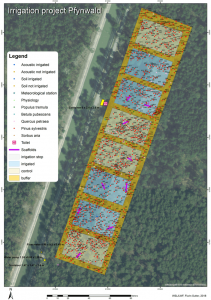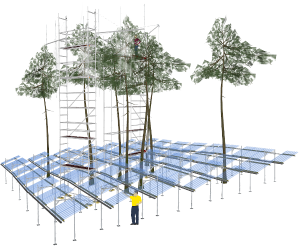
High evaporative demand (i.e., vapor pressure deficit or VPD) is an important factor influencing plant transpiration. VPD has increased in the context of global warming in recent decades, and can be referred to in highly simplified terms as “air dryness”.
We aim to apply a scale-spanning approach to disentangle the processes affected by atmospheric (i.e., VPD) and soil droughts from the tissue to the tree and the ecosystem level. Our objective is to set up the first atmospheric humidity and soil moisture manipulative experiment in a mature natural forest. We will combine air humidity (and thus VPD) manipulation using a humidification system in the canopy of adult trees and a below-canopy throughfall exclusion system.

The system will be installed at the long-term Pfynwald irrigation experiment, a pivotal monitoring and experimental site in a pine forest in Valais, where the effects of soil drought have been studied since 2003. The site benefits from extensive data series, including more than 120 parameters collected at the tissue, tree, and ecosystem levels.
The project consists in operating a high-pressure air humidification system in addition to the existing irrigation system, which serves to partially increase the soil moisture. With six nozzle fields installed in the area of the treetops, the vapor pressure deficit will be reduced specifically by 20-30%.

In addition and by means of the below-canopy throughfall exclusion system, the precipitation will be reduced by approx. 50% with the help of six rain shelters.
The combination of precipitation reduction with a VPD manipulation experiment in an old-growth forest is worldwide unique but, at the same time, urgently needed to provide a critical empirical test platform to assess the mechanisms of climate change impacts on temperate forests.
Project lead
Professor Charlotte Grossiord
Link to website of the project: https://www.wsl.ch/vpdrought